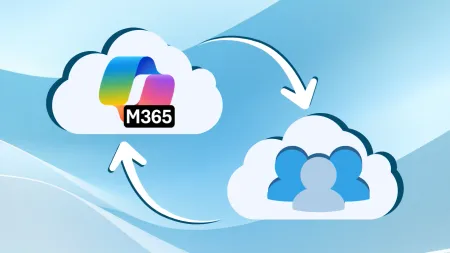Key Benefits and Challenges of Migrating to Microsoft Azure
Migrating to Microsoft Azure offers scalability and security, but it comes with challenges. Explore the key benefits and hurdles of Azure cloud migration.

Key Benefits and Challenges of Migrating to Microsoft Azure
Migrating your workloads to the cloud can prove to be extremely beneficial, as leveraging the power of the cloud can help you stay ahead of the competition by giving you access to powerful computing resources, virtual machines, and web development tools that many small to medium-sized businesses (SMBs) could not afford on their own. Of course, moving to the cloud can be a daunting task, as you may not know where to start or what cloud environment you should operate in. If your organization is already using Windows products and operating systems, your best option would likely be to take advantage of Microsoft Azure.
Microsoft Azure is a popular cloud computing platform that offers a wide range of valuable services, including cloud storage, mobile app development tools, machine learning services, virtual networks, and collaboration tools that can help you streamline operations and grow your business. This has made Azure a key player in the cloud landscape and the go-to platform for businesses looking to enhance operational efficiency and scale their operations.
Yet, while migrating workloads to Microsoft Azure can be extremely beneficial, this process can also be challenging for SMBs who may not have the knowledge and experience to ensure their cloud migration goes smoothly. Before you jump into an Azure migration, it’s essential that you understand the challenges you may face during your migration and what you need to do to ensure this process goes as smoothly as possible. Keep reading to learn more about why you should choose an Azure cloud migration, the obstacles you may face during this process, and best practices to ensure a smooth migration.
Key Benefits of Azure Cloud Migration
Microsoft Azure is a best-in-class cloud platform that provides an affordable, reliable, and scalable solution for businesses looking to move their workloads to the cloud. If you are considering migrating to Microsoft Azure but aren’t sure whether this is the right choice for your company, take a look at some of the key advantages of choosing Microsoft Azure:
Scalability and Flexibility
Microsoft Azure is a great choice for companies that need to be able to scale their infrastructure quickly. While installing on-premises IT infrastructure requires investing significant time and money up-front, which can be cost-prohibitive for growing businesses, with Microsoft Azure, you only pay for what you need. These on-demand resources make it much easier for your company to scale as your demands change, as you can adjust your subscription based on your business’s real-time needs without the cost-prohibitive up-front investments in hardware or software.
Cost Efficiency and Reduced IT Overhead
Since Microsoft Azure is scalable and you only have to pay for what you need at any given time, this can make it a cost-effective option that can help reduce IT overhead. For growing businesses, IT costs can quickly balloon out of control as you find yourself quickly investing in hardware, software, and personnel to meet your company’s growing needs. Alternatively, Azure’s pay-as-you-go model can help you significantly reduce costs compared to traditional on-premises solutions. Instead of needing to pay for expensive hardware or software licenses that you may only occasionally need, Azure’s flexible payment structure allows you to optimize your IT spending and allocate resources more efficiently.
Enhanced Security and Compliance
Another critical benefit Microsoft Azure provides users with is a comprehensive set of security features that can help them protect their data and ensure compliance. Azure’s built-in security features, such as the Azure Security Center, make it easy to prepare your business’s virtual infrastructure for compliance with common and vital regulations like GDPR, HIPAA, PII, and CMMC. By selecting the right pre-configured settings, you can secure your servers and online operations to smoothly meet and maintain compliance.
Improved Business Continuity and Disaster Recovery
Choosing Microsoft Azure can also help improve your business’s disaster preparedness by providing vital business continuity features such as backup, recovery, and failover for virtual machines and physical servers. Azure then provides critical data redundancy that can help keep your essential resources online and minimize downtime should a disaster or cyber-attack cause your servers to go down. Should something go wrong on-premises, Azure’s backup and recovery solutions can help improve your business continuity.
Integration With Microsoft Ecosystems
If you already operate in a Microsoft environment, then Azure is the perfect cloud platform for your organization. This is because Azure is a Microsoft product, which means that you won’t have to worry about how it will interact with your current software stack. Azure is designed specifically to integrate with Microsoft Ecosystems, and it will pair perfectly with your Microsoft 365 environment.
Common Challenges of Azure Cloud Migration
While migrating to Azure can be extremely beneficial, the migration process can also pose several challenges and obstacles. Knowing the potential challenges you may face when migrating to Azure is essential, as this can help you weigh the pros and cons to decide whether migrating to Azure is the right choice for your organization. Some of the most common challenges you may face when migrating to Azure include:
Complex Migration Process
One of the biggest challenges you will face during an Azure migration is that a large-scale migration can be an extremely complex process that will require extensive planning and organization. The fact is that Azure migration can be complicated and time-consuming, and thoughtful planning will need to take place to ensure that this process goes smoothly and your data is kept secure during migration.
Data Security and Compliance Concerns
Speaking of data security, another significant challenge you will face during an Azure migration is ensuring that your data is secure during and after the migration. While Microsoft offers comprehensive security and compliance features in Azure, it will be up to you to configure your security settings during the migration to ensure that your data is properly protected. Misconfigurations, like overly permissive access controls or unencrypted data transfers, can create vulnerabilities and even lead to data breaches and compliance failures.
Managing Migration Costs
While migrating to Azure has the potential to provide both short-term and long-term savings, Azure can be expensive if you don’t properly manage your usage and expenses. Inefficient resource utilization or spikes in usage can quickly lead to unexpected costs. Before using Azure, it is then essential that you have a clear understanding of what your needs are so that you can choose the right service plans. After migrating to Azure, make sure that you get in the habit of monitoring your usage early on so that you can ensure that you’re not overspending on unnecessary services.
Downtime and Business Disruptions
When preparing for an Azure migration, it is important to remember that downtime and business disruptions are possible. However, while it may not be possible to completely eliminate downtime, proper planning can minimize the impact of the migration on your business. One way that you can minimize downtime is by using a phased migration strategy.
Skill Gaps and Training Needs
Cloud migration is a complex process that requires a different skill set than on-premises IT, and your staff may not have the knowledge and skills to facilitate this process. A successful Azure Migration might require some upskilling for your IT team to continue effectively maintaining your business platforms, software stacks, and website portals on the cloud. To ensure a smooth transition to the cloud, it may be necessary to bring in Azure-certified professionals to manage the environment and train your internal IT team.
Best Practices for a Smooth Azure Cloud Migration
Fortunately, migrating to Microsoft Azure does not have to be a painstaking process. Knowing the challenges you may face ahead of time can help you create a migration plan that helps you migrate your workloads to the cloud. To help get you started, here’s a look at a few best practices you should follow to ensure a smooth Azure cloud migration.
Assess Your Current IT Environment
Your first step will be to assess your current IT environment and identify workloads, applications, and data that can be moved to the cloud. Using Azure’s built-in migration tool, Azure Migrate, can be beneficial during this stage by helping you assess your IT environment and plan your migration.
Choose The Right Migration Strategy
Once you’ve assessed your infrastructure, your next step will be to determine which migration strategy suits your business. There are several migration strategies to choose from, each offering a different balance in efficiency, functionality, and business continuity potential. A few of the most popular strategies include:
- Rehosting: Also referred to as lift-and-shift, rehosting involves moving applications and data directly to the cloud by simply copying applications and their dependencies from on-premises to the cloud.
- Re-Factoring: This involves moving applications to a new platform with some minor adjustments, such as changing the underlying database or operating system to take advantage of cloud-native services and infrastructure.
- Re-Architecting: Re-architecting involves redesigning applications individually from the ground up to be cloud-native, breaking down applications into smaller, independent services that can be deployed and managed separately.
Regardless of which strategy you choose, it is essential when planning your cloud migration that you prioritize crucial applications for cloud-readiness so that the transition is as smooth as possible.
Implement Strong Security Measures
When executing your Azure migration, it’s essential that you implement proper security measures such as data encryption, role-based access controls (RBAC), and multi-factor authentication (MFA) to protect your data and ensure compliance with industry standards. Fortunately, Azure provides great security tools that can lock down your cloud infrastructure when used properly. Azure Sentinel provides active threat monitoring, for example, while the Azure Security Center makes compliance easier.
Optimize Costs With Azure Cost Management
Utilize Azure Cost Management and Billing to monitor and control spending during and after the migration so that you can limit unexpected costs and usage spikes. This can help minimize overall costs while maximizing performance and scalability. You can also significantly reduce costs by leveraging Azure Reserved Instances, which offers users lower cloud costs if they commit to using specific Azure services, like virtual machines, for a set period of time.
Test and Monitor Post-Migration
Of course, once the migration is complete, your job isn’t done, as you need to continually test and monitor your cloud environment to ensure all data, applications, and services are functioning as expected. This will allow you to review and fine-tune your Azure resources to ensure efficiency, and it will also allow you to proactively identify and address issues. You will also want to conduct regular security audits to detect vulnerabilities and ensure you maintain compliance with industry standards.
When utilized correctly, Microsoft Azure provides an affordable, scalable, and secure solution for organizations looking to migrate to the cloud. Of course, as with any major change to your IT environment, migrating to Azure comes with its fair share of challenges, which is why it is essential that you take the time to thoroughly plan your migration to reduce risks and ensure that this process goes smoothly. Strategic planning and implementing security best practices will be essential in ensuring the success of your migration.
Of course, given the scope of an Azure migration, it is normal to feel overwhelmed by the prospect of starting this process. If you find yourself unsure where to start or how you can ensure that your Azure migration goes smoothly, consider contacting Agile IT for expert guidance. We can help assess your current IT environment and create a plan to ensure an efficient transition to the cloud.





